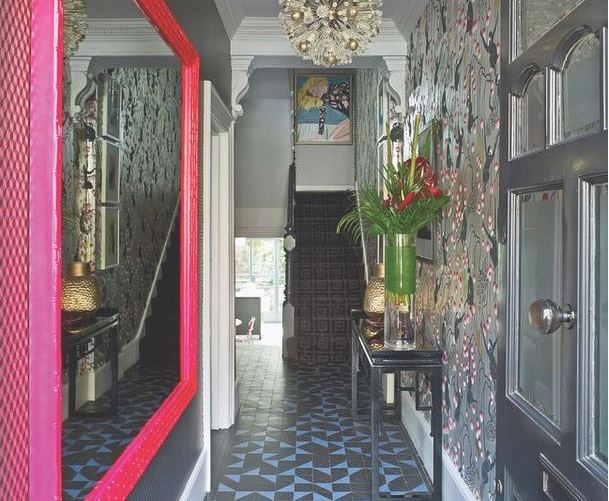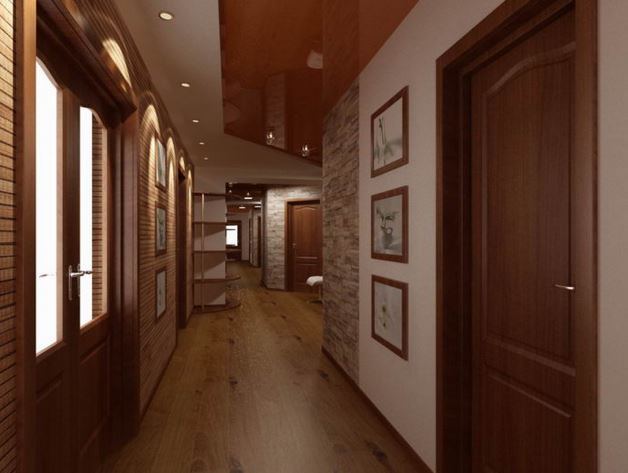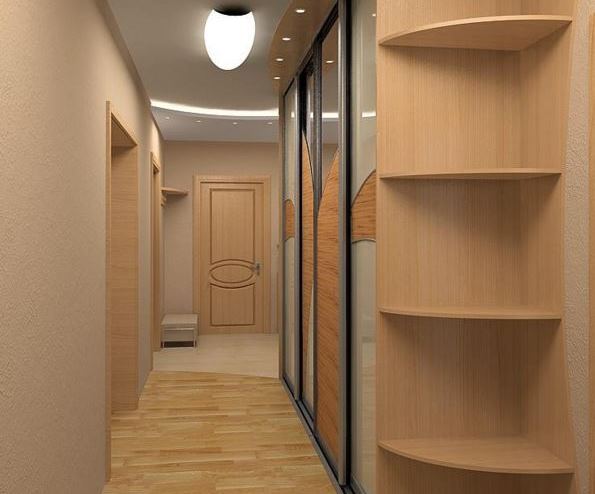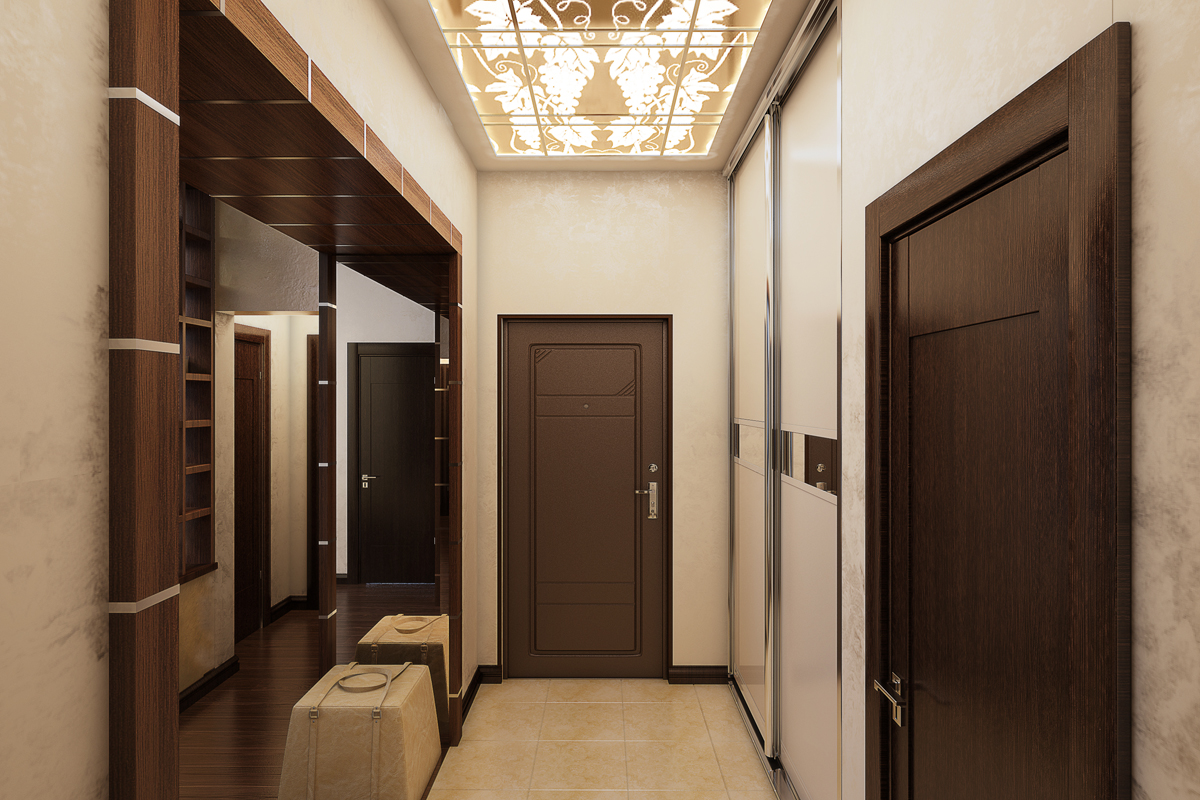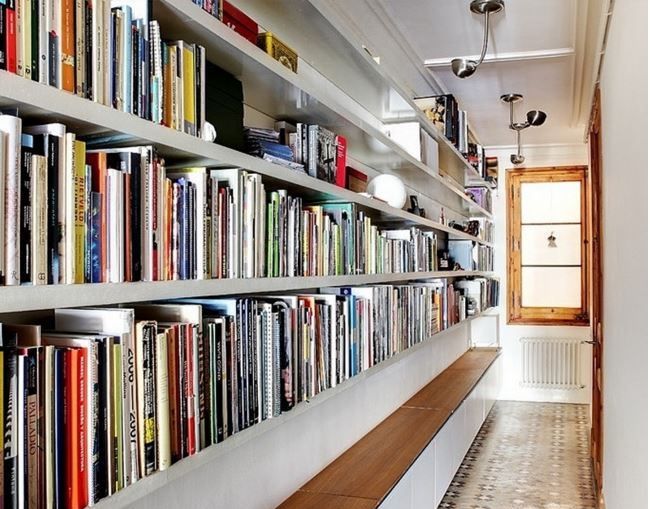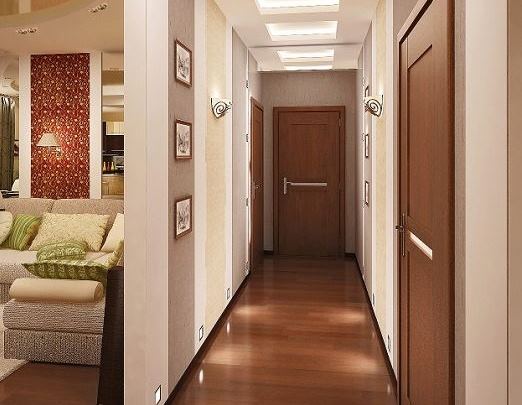Long narrow passage leading from front door from time immemorial was called a corridor.
With the change of eras, the name was not lost in the annals of history. Preserved in its original meaning to this day, even the narrowest long corridor carries its load in full.
From the interior dictionary: corridor - a small vestibule, or hallway. The hall is adjacent to the corridor. But the hall differs from the corridor in its overall shape and impressive dimensions.
The hall, unlike the corridor, has not only large-scale parameters, but also different configurations - from oval shapes to versatility of angles. The hallway or vestibule, in turn, belongs to the category of residential, but smaller in size, while the corridor is not a residential premises.
A narrow long corridor can serve as a continuation of the vestibule, hallway or hall, located immediately behind the front door. Functional purpose the corridor is an interior continuation, while the remaining rooms are an interior opening.
The corridors have different lengths. There are existing projects in which the long, narrow corridor is of great length, going deep into a residential building or apartment. The biggest drawback of this room is the lack window openings. Only doors leading to living rooms. Therefore, the designer’s first priority is to properly provide it with additional lighting, visually expanding the walls so that the corridor does not look like a tunnel.
“The challenge in creating a design for a narrow space, often with a very high ceiling, lies in the area of reorienting the space. Using mirrors on the walls, reducing the height of the ceiling and equipping it with materials with a reflective effect are the primary tasks for creating an interior in a narrow opening,”
says the general designer of the architectural studio Odnushechka, art designer Sergei Tikhomirov.
When creating an interior for a narrow long corridor, you need to take care to free the space from unnecessary details and massive structures. If it is necessary to place sliding wardrobes, it is advisable to choose a non-standard version of a long, shallow wardrobe of maximum length.

To visually expand the space, install two or more mirrors along one wall. The opposite side, as a rule, is decorated with paintings or artistic modeling, leveling the spatial effect of emptiness.
Choosing colors for the interior of a narrow corridor
Choice color range for narrow confined space, as a rule, lies in the bright spectral region. As a rule, designers use delicate pastel colors using blue, lilac, beige, sand or light green shades for the walls, giving the main preference to decorating the ceiling in white.

The ideal color solution for a narrow corridor that does not have a direct light source is white and all its shades. But in this case, much attention will need to be paid to the design of the walls, otherwise the corridor will turn out boring and uninteresting.
Remember! The color of the ceiling should be several shades different from the walls.
Ceiling decoration in a narrow corridor
To avoid the effect of being in a well, many designers use the following for the ceiling in a long, narrow corridor:
- suspended ceilings with a reflective surface;
- unity of color scheme of floor and ceiling;
- two-level structures with a central placement of the main part of the surface;
- ceiling lights hidden in one of the levels.

Two-level stretch ceilings visually not only level the surface, but also expand the space. This effect is achieved by reducing the height of the room and the lightness of the structure. Proper concealment of LED lighting in the internal level in combination with the glossy surface of the ceiling gives volume to a cramped room.
Lighting a narrow and long corridor
Being the only object in the house where there is no natural light, the corridor requires a carefully thought-out design for the supply of light. To optically enlarge a narrow space, bright lighting is used in combination with a light coating of wall panels.
Attention! The use of fluorescent fluorescent lamps is extremely undesirable, since they tend to transform colors and disrupt color rendition.
IN modern projects So-called “halogen lights” are installed in the corridors. Their light is spectrally closest to daylight.
Two lighting tips to help avoid cluttering a tight space:
- do not use hanging chandeliers in the interior;
- apply the principle of combined lighting.

The room will seem spacious if spotlights are used in the interior in combination with wall lamps. Illuminated mirrors, shelves and wall hangers will visually expand the walls. When installing glossy ceiling, the lamps are installed flush with the floor and reflected in it, giving the effect of double lighting, thereby expanding the space.
Floor in a narrow corridor
The design technique of decorating the floors and ceiling in one color helps relieve the feeling of cramped space. Even if you use light shades for the floors and ceiling, and the walls are done in darker colors.
Materials used as flooring can be very different:
- laminate;
- linoleum;
- batten;
- parquet;
- ceramic tiles.
For the floor in the hallway, the durability of the coating is considered an important point. This is the busiest place in the house, the floor of which is walked on several dozen times every day.
It is important to know that the laminated boards are laid perpendicular to the walls, which optically expands the space. The diagonal laying of materials also visually pushes the walls apart.
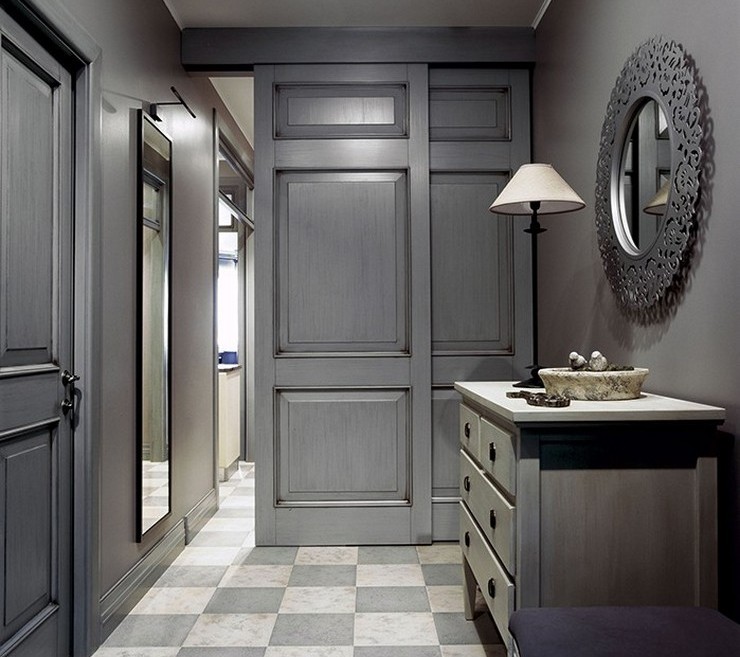
Some tips for decorating the floors of long narrow rooms leading to other rooms, including the bathroom and kitchen unit:
- Laying ceramic tiles or artificial stone floor in the hallway, create a continuation of it in the kitchen and in the bathroom.
- Laying out the hallway floor with parquet or edged board, keep the styling style as in living rooms oh, and in utility rooms, with the exception of the bathroom, where it is advisable to lay the floors with tiles to match the main covering.
- Do not use glossy ceramic tiles as a coating, no matter how advantageous the light sources look. Coming from the street after rain, it is very easy to slip on such tiles.
- Make the color of the floor and ceiling as close as possible, even if they are dark. In this case, this option can be played with light and very light walls of the room.
Hallways for narrow corridors
In a narrow, cramped corridor, hallway furniture is usually placed along only one wall. The width of the hallway is non-standard, and is no more than 50 cm in depth. It is preferable to equip cabinets with sliding doors so as not to take away the space of an already narrow corridor.
This hallway can be assembled by hand or made to order. The number of sections, closed and open areas is regulated by the preferences of the owner of the living space.
The main and fundamental aspect remains the fact that the hallway carries a multifunctional load with a small corridor area.
Long corridor in the apartment photo of author's works
Author's works on creating an interior in a narrow space literally attract close attention. These are bold solutions using bright colors in combination with a milky white ceiling color.
The most numerous color palette belongs to green. It is green that can become that connecting link and the moment of transition from the corridor to any room.
“Green is the color of optimists, capable of lifting spirits without being tired. Using green and all its shades in a narrow space, even outside of combinations with a white ceiling, can significantly expand the space,”
I'm sure private Moscow interior designer Natalia Semagina.

The bold work of private Moscow interior designer Anton Shlyapin involuntarily attracts attention. Using dark shades combined wallpaper in combination with a glossy ceiling that reflects light and a floor tiled to match the ceiling, it gives the feeling of a spacious room. Bright green lights at the end of the corridor open up the perspective of the space.

Some interesting works famous domestic and foreign designers, including their use of bright colors in the interior of hallways:

 Mexican motifs in the interior of the corridor
Mexican motifs in the interior of the corridor  European style corridar
European style corridar 

Narrow, non-standard corridors cause so much trouble for owners. Something is still missing ready-made solution for the design of such rooms. But if you are determined to decorate your home with taste, then you should pay special attention to the hallway. After all, this is where you can implement a lot of your creative ideas into life.
Tasks and difficulties of designing narrow hallways
When decorating the interior of a narrow corridor, you need to solve a number of problems:
- Expand the space. Mirrors, spot lighting and light shades of the walls will help here;
- Increase the functionality of the room. Sliding wardrobes, tiny shoe stands and hanging shelves will be fully appropriate;
- Get rid of unnecessary doors. If you keep the doors to the kitchen or living room constantly open, then replace them with an arch;
- Make sure there is good lighting;
- Create a “dividing strip” between different rooms. Moreover, it is important not to deviate from the general concept, the same for the entire apartment.
Stylish design of a narrow corridor
A number of mistakes should also be avoided:
- Use of huge and heavy lamps;
- Choice of dark tones;
- Heavy clutter with furniture;
- Large pattern on the wallpaper;
- The use of elaborate and bulky finishes;
- Limited passage due to furniture;
- A sharp contrast in the style of the hallway with the style of the rest of the home.
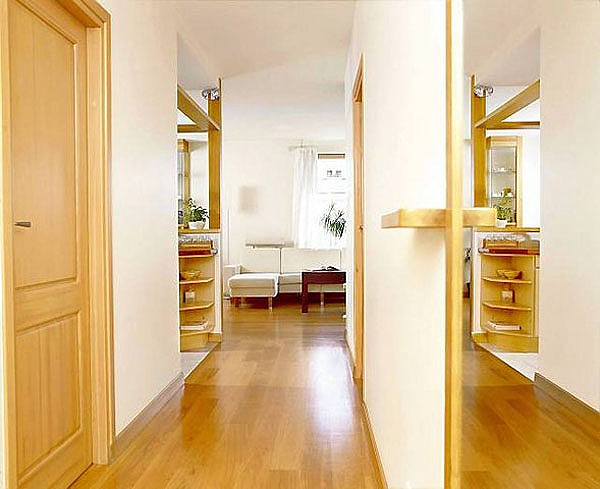
Mirrors visually expand narrow corridor
A narrow corridor will help to visually expand the use of flooring. Remember that parquet and laminate must be placed across the length of the corridor. It is better to lay carpet or linoleum with a transverse stripe.
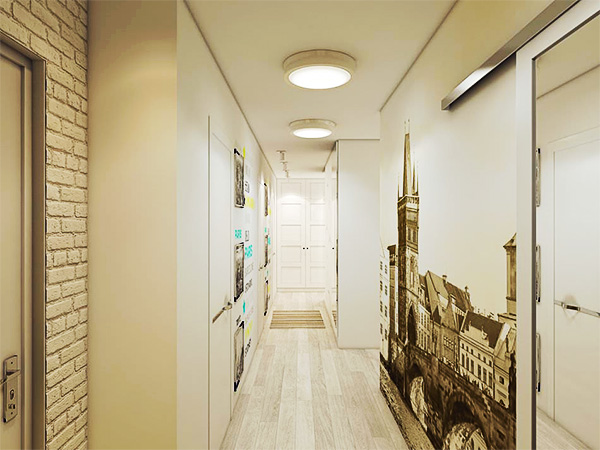
Sliding doors save space
The ceiling should simply be whitewashed or painted. If you have enough cash, then you can make a suspended or modular ceiling, and also use various modifications. Another effective technique in our case under consideration - “raising” the ceiling by removing unnecessary doors. By the way, many designers recommend instead of the usual swing doors use sliding ones.
Color scheme for narrow hallways
Don't overload with colors color design. When choosing paint or future wallpaper opt for light shades. In our case, white color is almost ideal, but it also has some disadvantages, for example, a high degree of contamination. You can choose beige or light green instead; cool blue colors will add airiness. In combination with white, you can choose burgundy, sapphire or purple.

Design of a narrow corridor in light beige tones
The corridor should not look monotonous and gloomy. It is best to simply divide the walls and floor into certain sectors, that is, apply fragmentation. Of course, you shouldn’t turn the hallway into a kingdom of colorful little flowers. The use of combined finishing will look successful, and vertical division will visually increase the height of the walls.
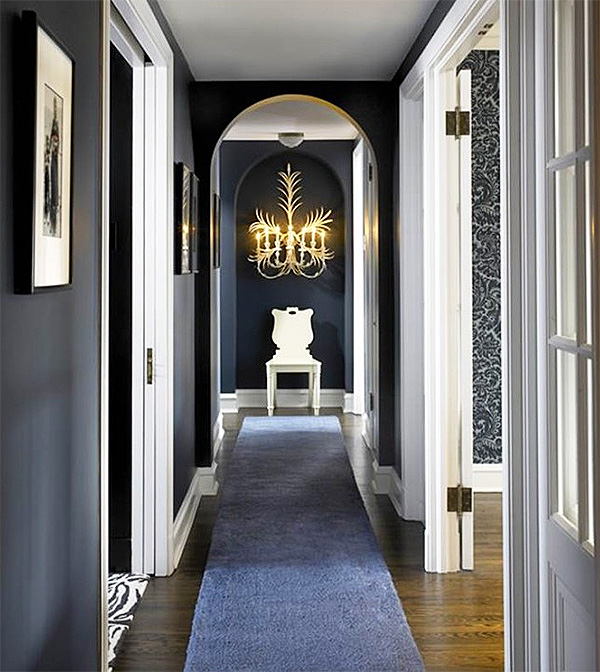
Dark colors are not best solution for the corridor
You should also pay attention to the floor in the hallway. So this is where increased loads fall on it. Tiles, laminate or parquet must be strong.
Furniture selection
Which one do we choose? Ideally - on built-in elements, and minimalist ones at that. Long wardrobe will make it possible to use the room also as a storage room.

Wardrobe in a narrow corridor
Naturally, there is no way to install a full-fledged, impressive-looking wardrobe in a narrow corridor. But fortunately times have changed.
Advice. Wardrobe with sliding doors perfect for a small hallway. Nowadays many companies offer custom-made services.

Narrow cabinet
Thanks to the use of mirrors, a narrow corridor can be visually expanded. It is advisable to hang them on the side walls of the corridor. Mirrors will further help cope with the lack of space, and will also add an interesting appearance and functionality of the room.
Even if there is no place to put a wardrobe, then all you have to do is use regular clothes hanger, separate stand for shoes. But at least one mirror should hang on the wall, because even the smallest mirror surface visually expands the space. She recommends nailing a shelf with hooks for umbrellas under the mirror.

Console table
Wall mounted console tables ideal for such premises. Elegance and functionality are what they will give to the room. We advise you to pay attention to narrow hanging cabinets. For convenience, it is necessary to install ottomans. In addition, you can put some small things in them that are useful in everyday life.
If you are lucky with high ceilings, then you can safely place mezzanine cabinets. However, we do not recommend posting them tall people, otherwise you may get hit on the head. By the way, it is now very fashionable to use wall panels with pockets where all the small things are stored.
Wall decoration
The color scheme in narrow hallways, as we have already said, makes a significant contribution to the overall impression of your home. To give this small corridor original design, it makes complete sense Avoid using rich and dark colors. Of course, they are very practical, but the chosen solution will only narrow the already narrow corridor. That is, most suitable option in this case, choose light colors.
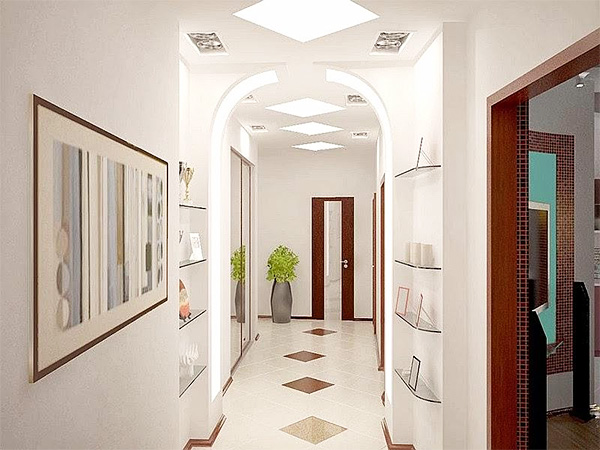
![]()
Tile is the most practical covering
The positive aspects of tiles are obvious. All accumulated dirt can be easily washed off. There is only one negative point about this - low temperature. In this case, part of the tile is covered with carpet or carpet, and at the entrance everything is left as is.
There is no consensus among experts about the color of the carpet. The light option is convenient from the point of view of visually expanding the space, but is not practical and gets dirty quickly. Only if cleaning is a joy for you, you can use a light carpet.

Linoleum - economical option for floor
Sometimes carpet is replaced with linoleum. It is as easy to clean as tile. Before purchasing linoleum, pay close attention to the pattern on it. Sometimes the owner of the house does not like a simple monochromatic design, then choose a design that will expand the space.
When renovating an apartment, many always start with the living rooms, leaving the hallway for last. By this point, all the enthusiasm may have passed, and there is a desire to end this natural disaster as quickly as possible. Therefore, corridor repairs are often done hastily and anyhow. This is where the main mistake lies.
The main mistake is leaving the repair of the corridor until last
Despite the fact that apartment residents spend a minimum of time, this room still remains the hallmark of the home. Visitors who enter the apartment will evaluate it based on the first impression, which is created by the hallway-corridor. Therefore, it is so important to pay serious attention to this room.
slideshow
By choosing the right design for a small room, you can immediately solve several problems:
- With the help of finishing paints and properly positioned lighting, the space visually expands.
- In order not to clutter up an already small room with furniture, you should use built-in wardrobes or opt for the “compartment” option. Those hung on the walls can take on some of the functions of storing things.
design of a narrow corridor in beige tones

- It is impossible for the corridor to fall out of overall harmony, since its main function is to connect the rooms into a single living area. Therefore, the style of all rooms should be “consonant” with each other, as well as the color scheme.
the transit room should fit into the overall concept of the apartment
Wall decoration in a small space
A corridor is a room through which the apartment comes into contact with the outside world, from which dirt and dust are brought inside. Therefore, when decorating a hallway, the main focus should be on practicality, choosing durable, wear-resistant materials.
It is better to use for finishing practical materials
Before finishing the walls, they are leveled. Drywall speeds up the process in such situations, but in the corridor this option immediately disappears, since such a finish takes up part of the space (and here the square footage is already too small).
from minimalism to country
If you give preference, then it will be quite practical, and there is no need to do labor-intensive plastering first - the texture of the wallpaper will hide everything. In the version with Venetian plaster, the walls will not only be smooth, but also aesthetically attractive.
variety of hallway design options
As for color solutions, due to the small dimensions of the room and lack of lighting, attention should be paid to light shades that increase the space. Delicate pastels will be just in place.
Since light paints are quite easily soiled, the material used for wall decoration must be moisture resistant and will be subject to frequent cleaning. Therefore, there is a reason to choose wallpaper that can be washed, for example, vinyl. There are special corridor or glass wallpapers available for sale that can be repainted several times.
light plain walls expand the boundaries of the room
At the same time, for a narrow corridor you cannot choose a finish with large drawings, otherwise the walls will “press.” Small horizontal ornaments (or stripes) that visually “spread” the corridor look best in such rooms. The vertical, raising the ceiling, will visually narrow the hallway even more.
a walk-through room shouldn't be boring
Original solutions in the design of a narrow corridor
The small dimensions make the walk-through room a somewhat boring room. Many owners believe that all sorts of delights and creative solutions- not for the corridor. If you use your imagination and add some zest to the design of the hallway, then this space can be made almost the most interesting in the apartment.
don't think that creative ideas not for the hallway
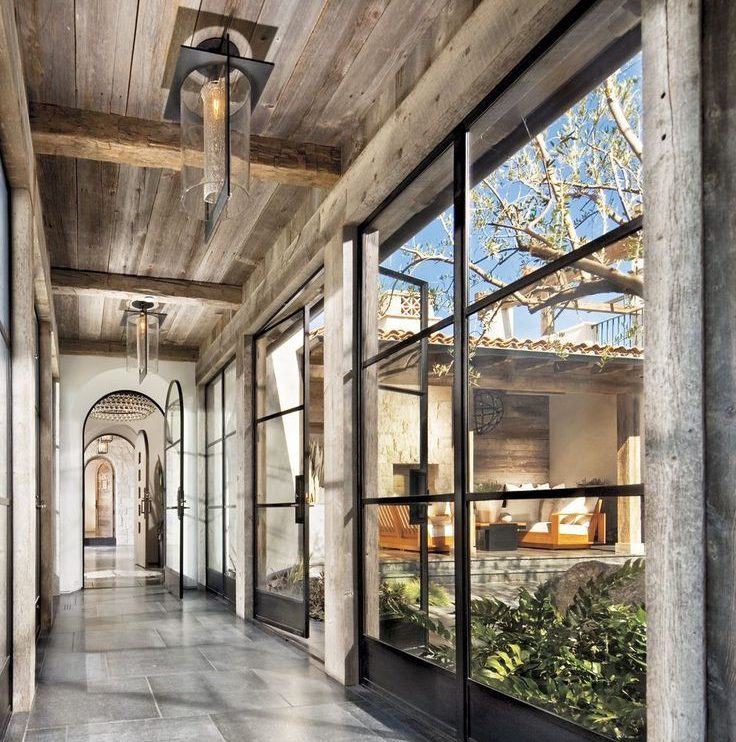
- Using regular tiles with patterns, you can create an original floor finish in the hallway (this material would be more appropriate here). They will look great - they are both aesthetically pleasing and more resistant to stains. If funds do not allow you to fill the entire corridor, you can limit yourself to only the area at the entrance, covering the rest of the area with laminate.
turn the hallway into a glory room
- Nowadays, combined interior decoration is in fashion, which can also be used in the hallway. A decorative stone is suitable for this, which goes well with plaster, tiles, stucco, wood, glass, bamboo and wallpaper. A small amount of masonry in a fragment of a wall (corner) or finishing of openings and niches is enough to make the corridor look fresh and attractive. The variety of textures of the stone itself will especially help with this.
narrow shelves and frames will be very useful
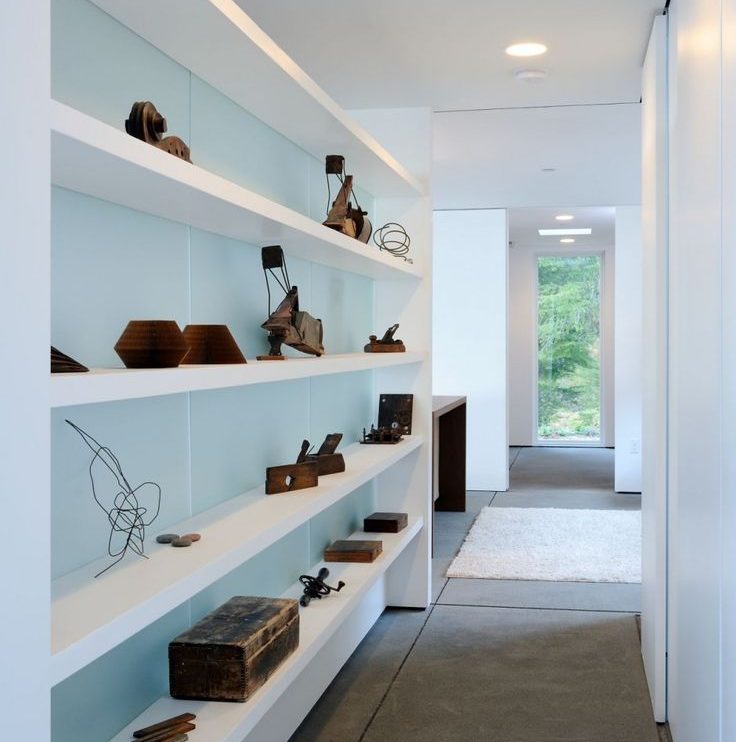
- You should not leave the walls unoccupied in the corridor - you can decorate them in your own way using paintings, family photos, posters, panels and flowers.
- If there are niches in the corridor, you can place collections collected by family members in them or install crafts, small sculptures, souvenirs, etc. In the absence of niches, shelves are used for this purpose, and additional lighting focuses attention on the interior elements, distracting the eye from the cramped space. By the way, niches in the hallway are an excellent option for storing things that do not have a place in the living rooms.
collections, paintings and schedules
- Ceilings play an important role in the interior of corridors. If this is a Khrushchev-era apartment with low walls, then a glossy stretch ceiling would be an excellent option. It will fulfill both the optical function and look beautiful from a design standpoint. Well, high ceilings will have to be lowered a little with the help of drywall, and multi-level structures will look great here. Relief patterns, arched elements, lighting - all this will complete the created image.
cabinets arranged in niches are almost invisible
The role of lighting
In most cases, corridors do not have windows, so artificial lighting there is a great responsibility. After all, with its help you can give the room a feeling of freedom or, conversely, turn it into a too gloomy room. To last option didn’t happen, you need to install spot lighting along the entire length of the hallway.
most often there are no windows in the corridor
Fans of fluorescent light sources should avoid using them in corridors, as these lamps distort perception more than add brightness. After all, it is so important to evaluate yourself objectively with your last glance when leaving the threshold. To bring the light in the corridor as close as possible to natural light, it is better to place halogen lamps here - they are more suitable in spectrum to the natural light flux.
variety of light sources for the hallway
Corridor furniture
The hallway is a room that should not be overly cluttered with furniture. Its main function is to provide transit around the apartment (that is, free movement). Although here you need a closet in which things for the outdoors will be stored (or just a convenient hanger).
A narrow corridor or a long hallway in an apartment requires thoughtful arrangement. The space must include all the necessary zones, and also be different beautiful design. For this purpose, a set of sequential actions is performed to ensure coziness and comfort.
How to design a long and narrow corridor in an apartment
The interior of the corridor reflects the hospitality of the owners of the house and the comfort of the conditions. Therefore, a long and narrow space needs careful planning. The small width of the corridor does not allow placing classic wardrobe or a set of furniture for the hallway. In a narrow corridor it is required proper organization all zones, allowing you to make the room comfortable and functional.
Finishing walls, floors and ceilings
Renovation is the first stage in arranging a living space. To finish a narrow and long corridor, select best practices. In this case, the area of the room is taken into account. For example, in a narrow corridor you cannot build plasterboard structures along the walls, which will lead to an even narrower space. If possible, it is worth visually and actually expanding the room. Thanks to this, the corridor will become comfortable and functional.
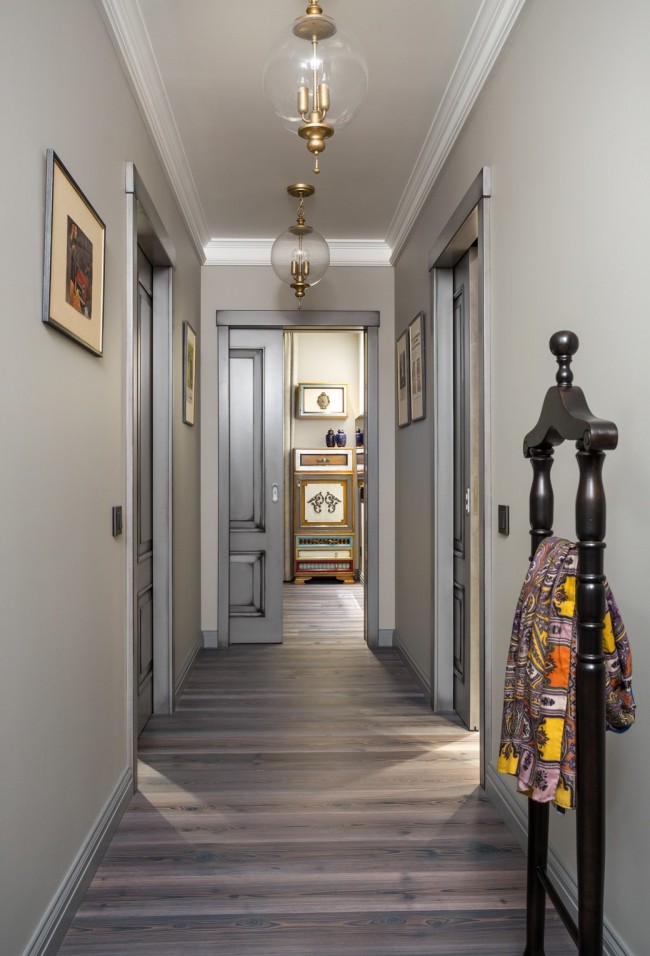
Laconic design and simple finishing are optimal for narrow spaces
The finishing of all surfaces in a narrow and long corridor should be practical and beautiful. For this purpose, methods are used that provide high-quality coverage. If the ceiling height is high, suspended, tension or multi-level structures are often installed in the corridor. As a result, the ceiling will become the main detail of the interior. And also in a narrow corridor, attention is focused on the flooring. To do this, it is worth using ceramic tiles, with which a certain pattern is laid out. Classic laminate and linoleum are suitable for any interior. Particularly impressive is a self-leveling floor with a 3D pattern. The original image should be combined with the overall interior of the narrow and long corridor.
Colors and shade combinations
The selection of shades and interior style is an important point in arranging a narrow and long corridor. Light colors visually enlarge the space and are therefore optimal for this type of room. At the same time, a colored ceiling or floor will make the atmosphere unusual and beautiful, but it is important to consider the height of the ceiling. If this indicator is quite small, then a colored ceiling covering will not give the atmosphere “heaviness” or massiveness. Large patterns and dark shades are also not suitable for a narrow and long corridor.
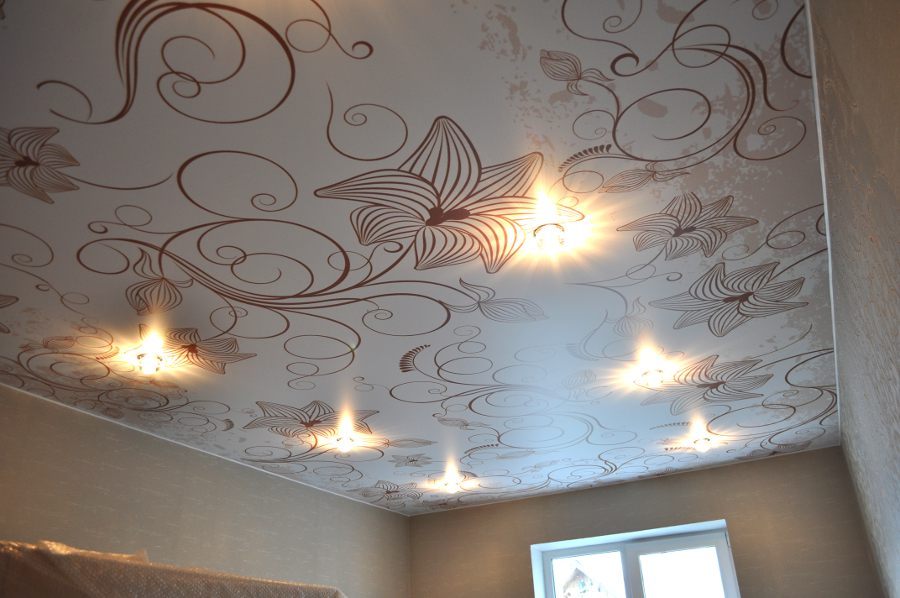
Patterns matching the color of the walls make the atmosphere harmonious
Combinations of contrasting dark shades inappropriate in the interior of a long and narrow corridor. In this case, the space will visually become narrower. Therefore, all options in light colors are suitable for the interior of the corridor. Neutral and bright shades go together easily, making them easy to mix and match.

Delicate shades visually increase the space
When choosing a color, it is worth considering that the floor and ceiling should differ from the walls by several tones. Bright contrasting design is inappropriate in a narrow and long corridor. White interior doors, beige shades or the color of the walls will not distort the visual effect of expanding the space.
Materials
You can create any texture of walls, ceiling and floor various materials. Ceramic tiles are optimal for flooring, but linoleum and laminate are often used. A stretch glossy ceiling allows you to visually make the space more spacious.
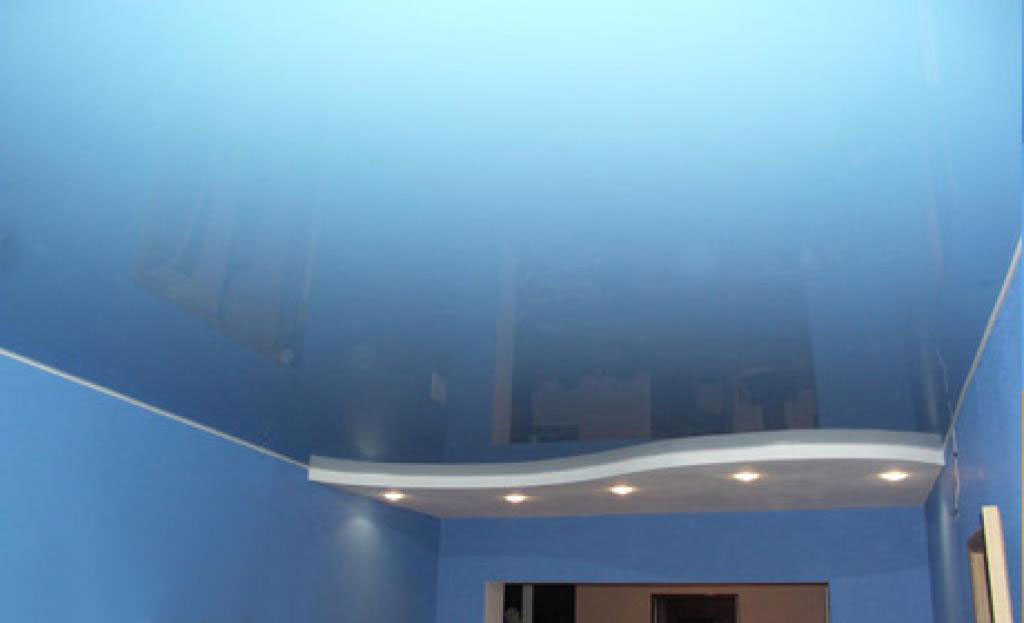
The glossy ceiling can be colored and complemented by original lighting
Various materials are used to cover walls. Optimal for an interior in Provence or country style decorative plaster. Visually highlight the entrance or interior doors can be done using facing bricks, the color of which differs from the color of the walls by no more than 3 tones. Plain, flat wall surface in a narrow and long corridor - best option to visually expand the space. In this case, it is worth using molding. High-quality wallpaper with a textured or smooth surface is universal.

Contrasting light wallpaper and lighting expand the space
Narrow wardrobe, small shelves and ottoman: choosing furniture
Furniture for a narrow and long corridor is an important point on which comfort and convenience depend. In a room whose width is about 1.5 m or more, it is possible to install a narrow closet for outerwear, shoes and other things. Furniture should not be too long and massive. A folding table under the mirror is appropriate in a narrow space. You can install a narrow ottoman nearby for greater comfort. The shoe rack is located near the front door.

Light and compact furniture will save usable space
A built-in wardrobe, which replaces one of the walls of the room adjacent to the corridor, steals useful living space, but ensures the preservation of the hallway area. The closet must have sliding or accordion doors. The presence of mirrors on compartment doors contributes to the optical expansion of the area. In a narrow space, compact furniture in a minimum quantity is necessary.
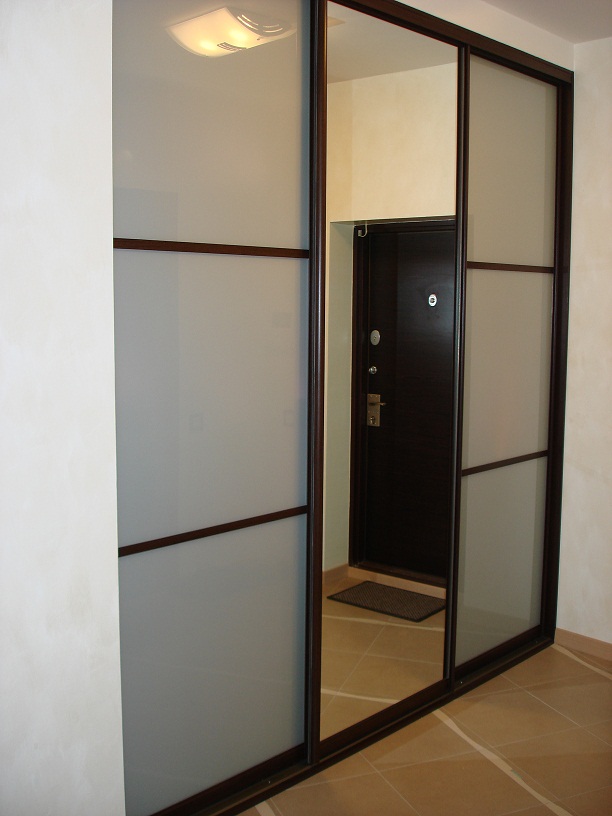
Built-in wardrobe with mirror elements does not take up useful space in the corridor
In a narrow and long room without the possibility of installing a wardrobe, ottoman and shelves, it is worth using folding furniture. Chairs, shelves, bookcases are attached to the wall and folded, and if necessary, the furniture can easily become functional.
Video: folding table for a small room
Lighting will help hide corners and expand space
Proper lighting provides comfort and allows you to visually correct the shortcomings of any room. In a narrow and long corridor, the main light source in the form of a chandelier may be missing. Spotlights are distributed along the perimeter of the corridor, which visually make the room more spacious. Against the background of a glossy ceiling, this effect is enhanced. A multi-level ceiling is often emphasized around the perimeter LED backlight. A mirror decorated with such elements is a bright detail of the decor.

Perimeter ceiling lighting provides comfortable lighting
Several simple chandeliers, square or rectangular shape And dark color will provide optimal lighting. The elements should be placed in the middle along the entire narrow corridor. If there are niches, paintings, mirrors in the room, then they should be emphasized with LED lighting using a special tape.

Illumination of pictures and multi-level ceiling make the environment stylish
Fluorescent lamps, a set of spotlights, additional wall fixtures, LED strips- all devices can be easily combined to create comfortable conditions. A well-lit narrow and long corridor looks more spacious and comfortable than a dimly lit space.
Items and decorative elements
A long and narrow hallway requires minimal decor. The walls are often decorated with paintings that match the style of the interior. Wall lamps are also one of the room decor options.

A bright interior can easily be complemented by large paintings or posters
Pictures with built-in lighting are spectacular. For example, an image of a fire or a burning fireplace with appropriate lighting makes the interior cozy. Large abstract images are appropriate on very light walls of the corridor, but drawings in dark colors should not be placed. All elements in a long and narrow space should match each other in shade saturation.
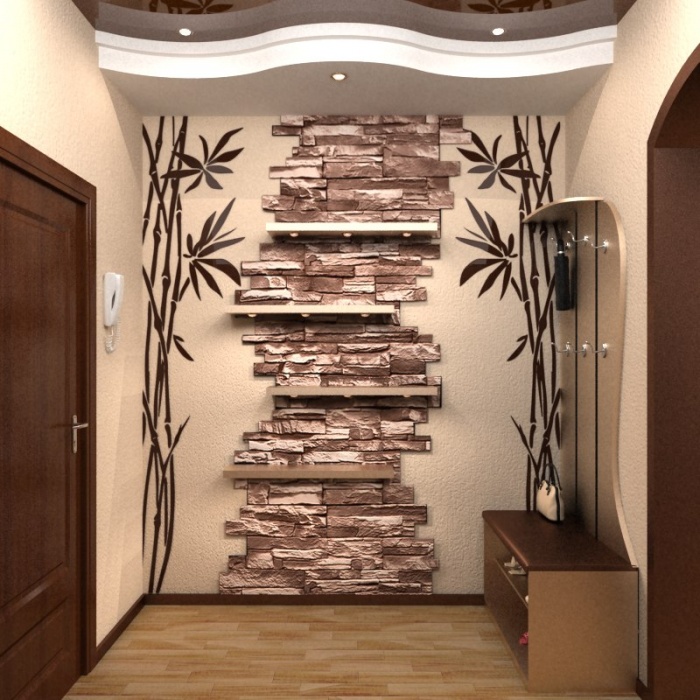
A composition of facing bricks and patterns is a spectacular detail of the decor
Decorative plaster is often used to decorate premises. The combination of a relief surface and mirrors or mirror mosaics is good option decor. Plain, smooth walls are decorated with contrasting patterns. At the same time, you should not use too small or extensive drawings on the walls. Such elements will not create the optical illusion of expanding space.
Photo gallery: narrow corridor design ideas
 Passport paintings - classic hallway decoration
Passport paintings - classic hallway decoration  Bright cabinet fronts on a white background make the interior stylish
Bright cabinet fronts on a white background make the interior stylish  Contrasting details on a plain background emphasize the solidity of the decor
Contrasting details on a plain background emphasize the solidity of the decor 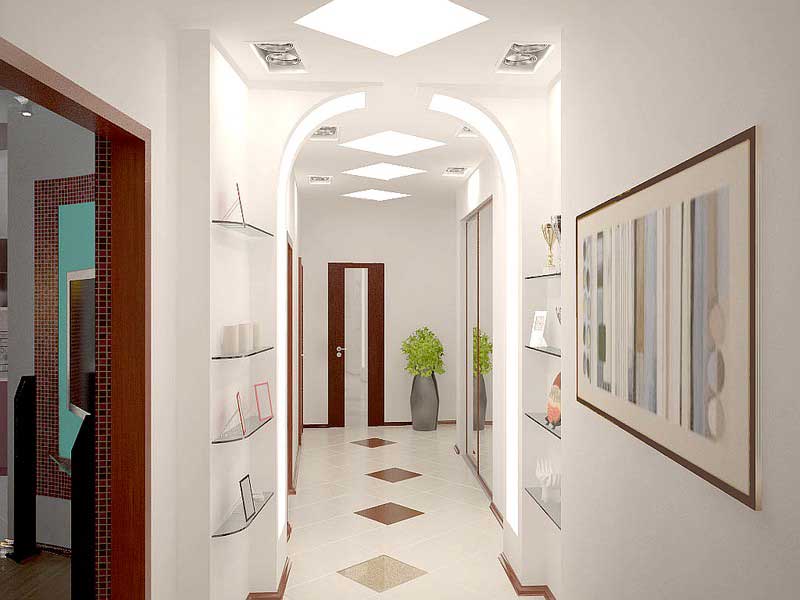 White surfaces can be easily decorated with contrasting details
White surfaces can be easily decorated with contrasting details  The interior in black and white colors does not affect the visual perception of the room
The interior in black and white colors does not affect the visual perception of the room  A mirrored end wall will emphasize the spaciousness of the corridor
A mirrored end wall will emphasize the spaciousness of the corridor 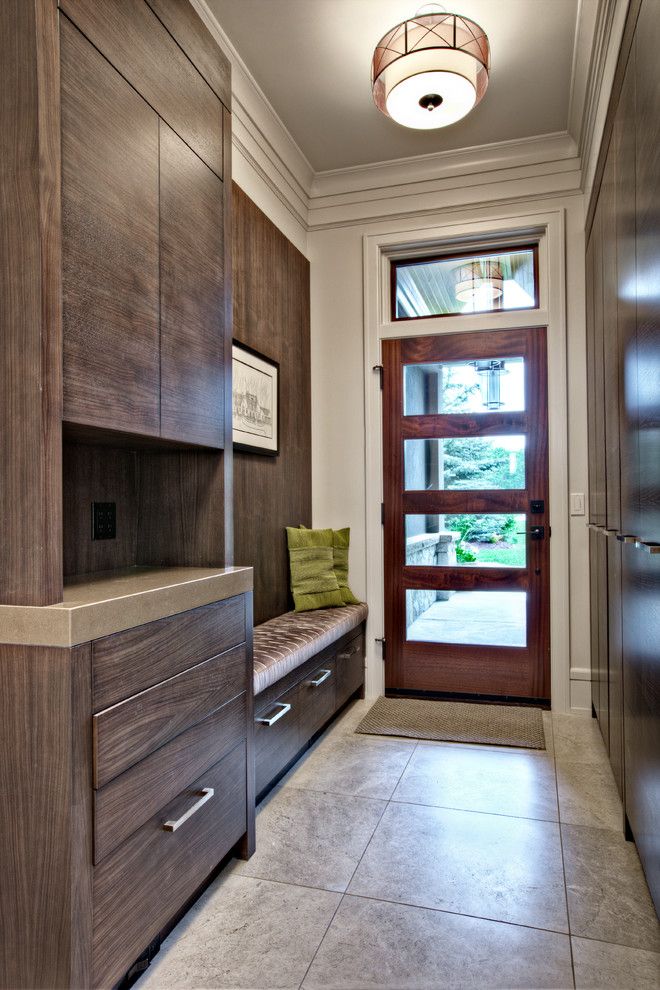 Laconic dark-colored furniture is practical in the hallway
Laconic dark-colored furniture is practical in the hallway 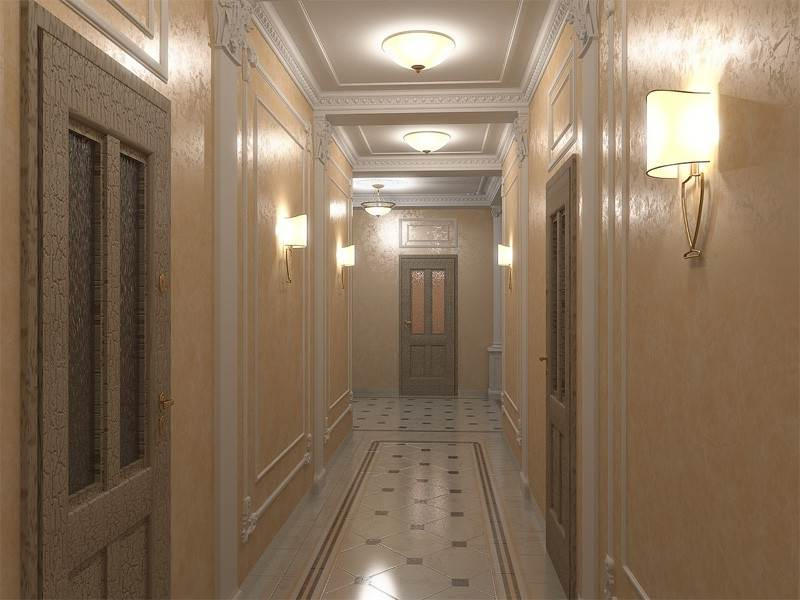 Classic style the interior is appropriate in a narrow corridor
Classic style the interior is appropriate in a narrow corridor 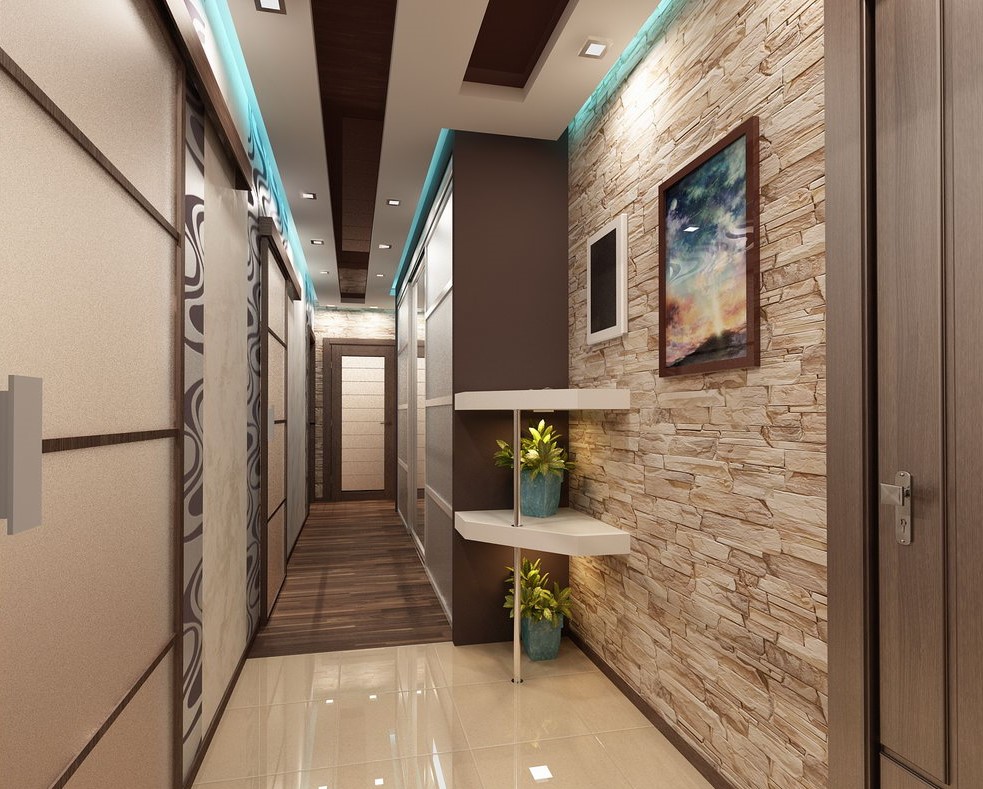 Facing brick easy to combine with patterns on the walls
Facing brick easy to combine with patterns on the walls 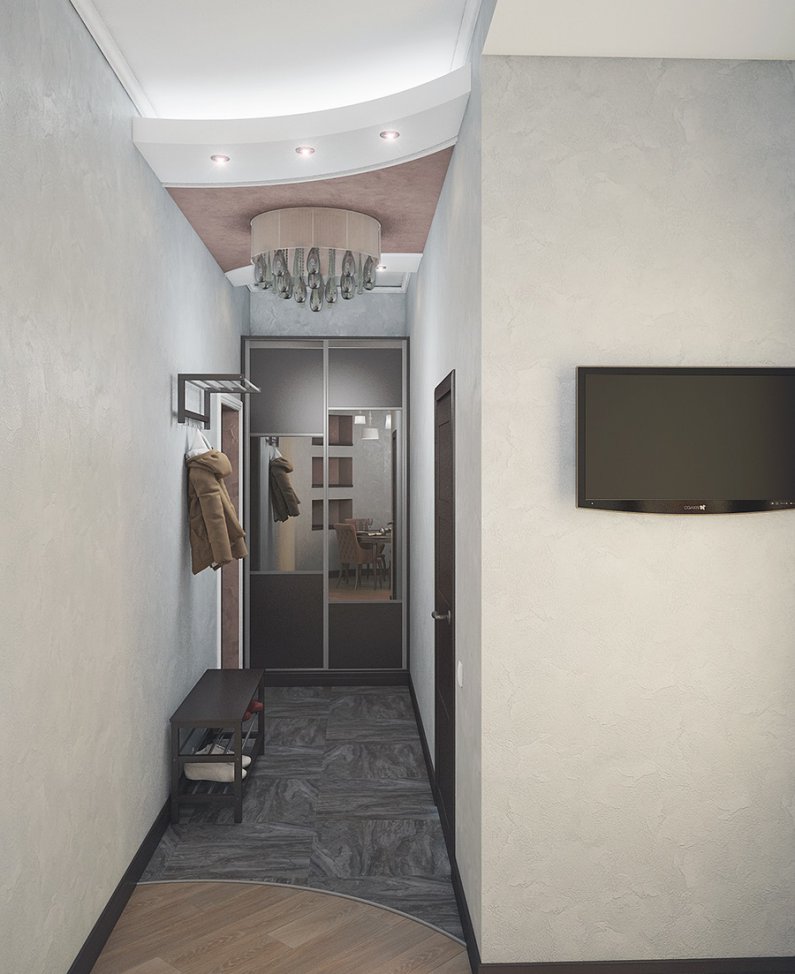 Compact furniture does not take up much space in a narrow corridor
Compact furniture does not take up much space in a narrow corridor
How to decorate a long narrow hallway
A long and narrow hallway can become a very cozy space thanks to careful arrangement. A variety of materials, furniture models, types of finishing and decor are suitable for this purpose. The right choice and compliance with repair technology - important points necessary to create a cozy space.
Finishing walls, floors and ceilings
During the renovation process, the walls, floor and ceiling are finished. In this case, it is worth considering the rules:
- light colors create an optical effect of increasing space and are suitable for long and narrow hallway;
- the minimum passage size should be 90 cm;
- the finish must be practical, durable and of high quality;
- During the finishing process, you cannot use methods that reduce space.

Simple finishing - universal solution for narrow spaces
The finishing and arrangement of the hallway involves several stages. In this case, the individual characteristics of the room are taken into account, for example, shape, ceiling height, location of interior doors and other factors.
Color solution
The choice of colors and their combinations for decorating a narrow and long hallway is varied. The principles of selecting a specific option are to use light colors. Contrasting combinations are appropriate, but require moderation. You cannot use dark, gloomy shades that create a “sad” effect and visually reduce the space.
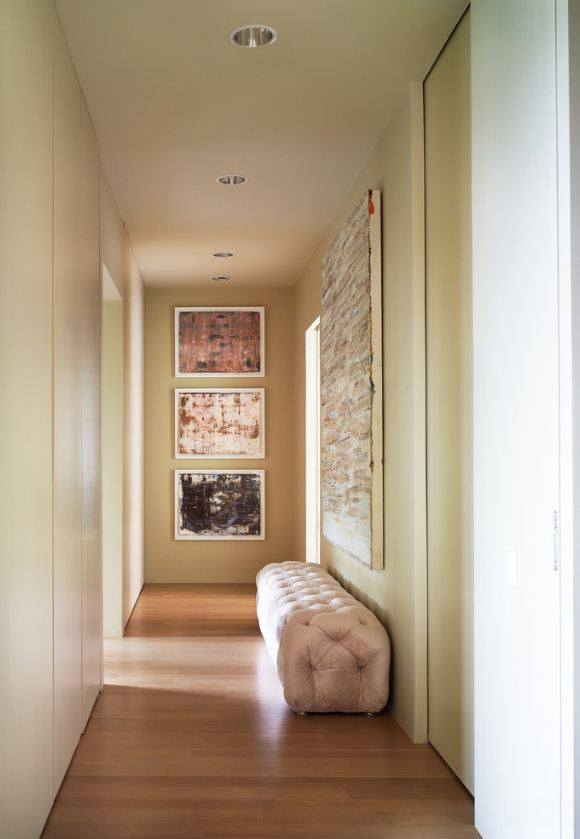
Light shades make the interior laconic and stylish
The original solution is contrasting flooring. In this case, you can use various combinations, for example, highlight the area near the front door with dark tiles, and decorate the rest of the space with material 2 shades lighter. The colors of furniture, interior doors, decorative elements and ceilings should not differ by more than 3 tones.
Materials
In the process of renovating a narrow and long hallway, various materials are used. The following options are effective:
- high-quality and practical wallpaper is easy to apply and allows you to quickly change the color of the walls if necessary. Too expensive and luxury options unprofitable to use in the hallway. Non-woven fabrics, as well as canvases for painting, are optimal;
- finishing walls with panels and constructing plasterboard structures lead to a reduction in usable area. Therefore, decorative plaster is suitable for walls, as well as facing bricks;
- Ceramic tiles with a rough surface will provide a comfortable floor covering. Lighter options are linoleum and laminate;
- The high ceiling of the hallway allows you to create unusual multi-level structures or create a tension covering. The hanging option is also optimal for narrow and long spaces.
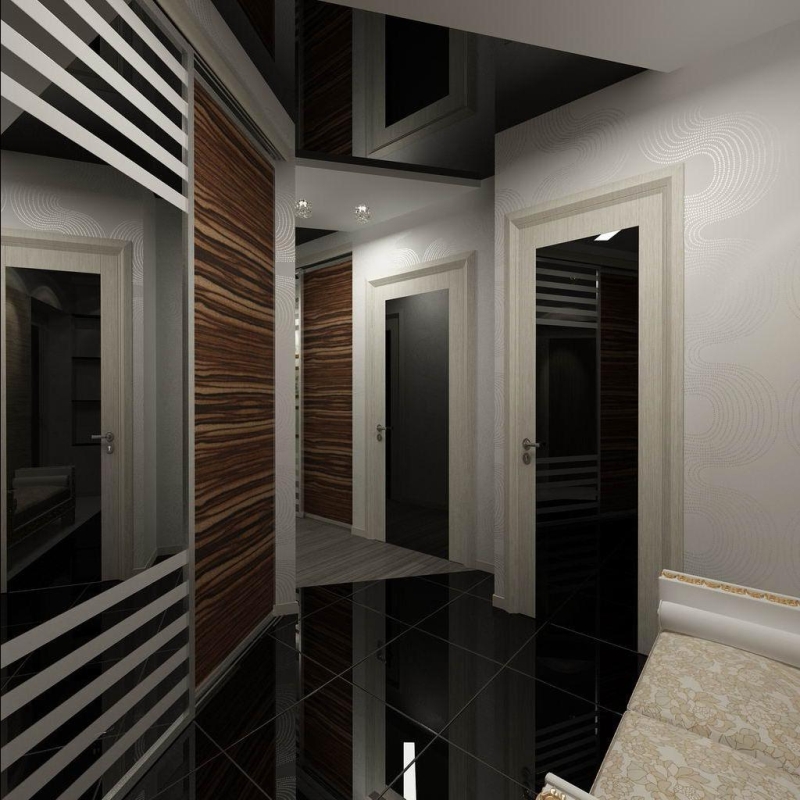
Dark glossy suspended ceiling Suitable for non-rectangular hallways
When decorating the hallway, practical materials are used that do not require special care. Mirror and glossy surfaces can create the effect of increasing space, but they should not be placed directly next to the front door.
Planning and zoning
Careful planning allows you to make a narrow and long hallway functional. Even small space need to be divided into zones. Near the front door there is often a shoe rack, a little further there is a mirror or a built-in wardrobe with mirrored doors, as well as an ottoman and a shelf.

Compact furniture and color separation are optimal for narrow and long hallways
The division of hallway zones is often done using color. The most effective option is dark design areas near the front door, slightly lighter trim near the closet, and the rest of the area is lighter. In any case, in a narrow and long hallway you cannot place many zones, use massive furniture and solid decor, which will not visually expand the space.
Furniture
The use of compact, multifunctional, practical furniture is an important rule for arranging a narrow, small space. Therefore, in the hallway there is often only a low chest of drawers for shoes, the top cover of which serves as a seat. The mirror can be of any size, and hang it near the door. A folding shelf will provide convenient storage things. And folding furniture options are also effective: table, seat, hanger. The elements are attached to the wall and can be easily unfolded if necessary. Used to save space interior doors-accordion or coupe.

The minimum amount of furniture allows you to save useful space in the hallway
In some cases, it is possible to install a built-in wardrobe in place of one of the walls in the rooms adjacent to the hallway. A narrow small wardrobe is installed with a space width of at least 1.5 m, and the depth of such furniture is up to 40 cm. Arranging shelves above the mirror and in the free corners of the room allows you to save space and effectively store things.
Lighting
The correct location, choice of type and intensity of lighting sources allows you to create the optical effect of expanding a narrow hallway. This requires bright light. The optimal solution is lighting in the form of a complex of spotlights, which are arranged in different ways. Several lamps placed along the hallway in the center of the ceiling provide uniform lighting.
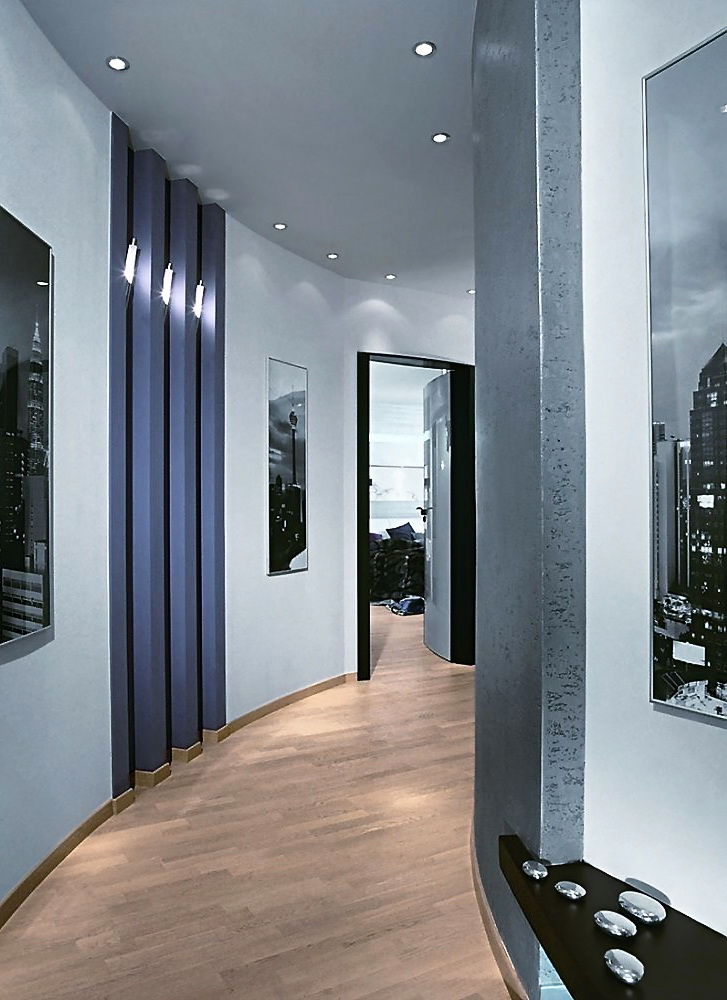
Spotlights are effective in any room
Combination of several types of lighting sources - good decision to separate zones. Wall lamps, LED complexes, classic chandeliers can be easily combined, making the space comfortable.
Decoration
Decorating a long and narrow hallway involves using light decor in small quantities. At the same time, the design should not include massive objects that burden the situation. Mirrors are an essential element of a long and narrow hallway. The presence of glossy and mirror surfaces contributes to the visual expansion of the room.
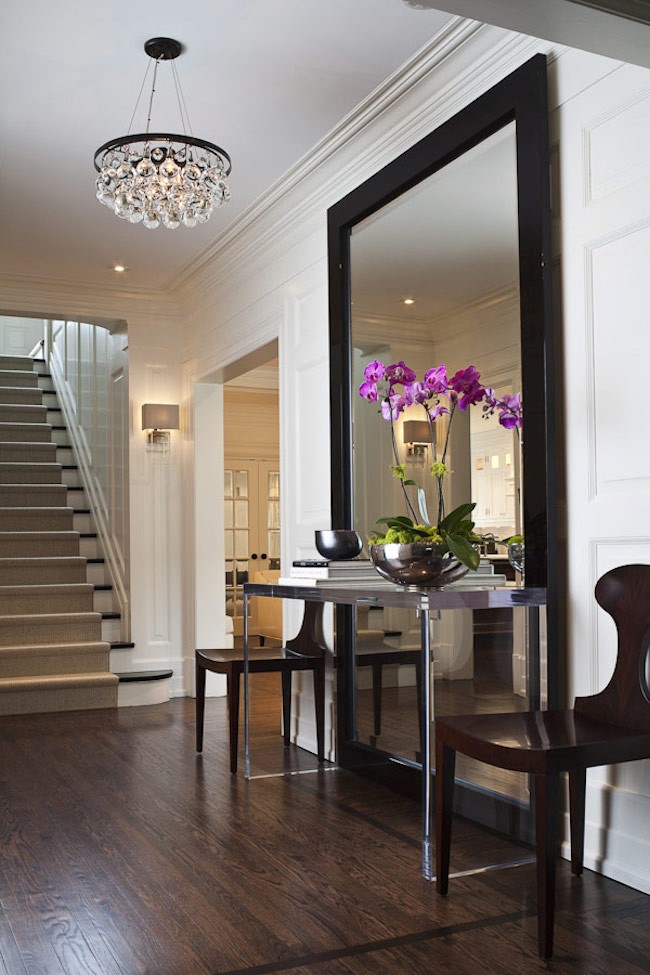
Large mirror is easy to use
Medium and large-sized paintings are appropriate against the background of plain light walls. At the same time, the frame of the paintings should not be massive or too dark. Small wall lamps universal. In the corner of the hallway there is often a set of shelves for storing small items. If such elements are made of transparent glass or plastic, then this will not affect the interior of the hallway.
Pattern from ceramic tiles on the floor is also one of the room decor options. Colored or multi-level ceiling covering with original lamps affects the interior of a narrow hallway. At the same time, all decorative elements should be compact and practical.
Photo gallery: interior of a narrow hallway
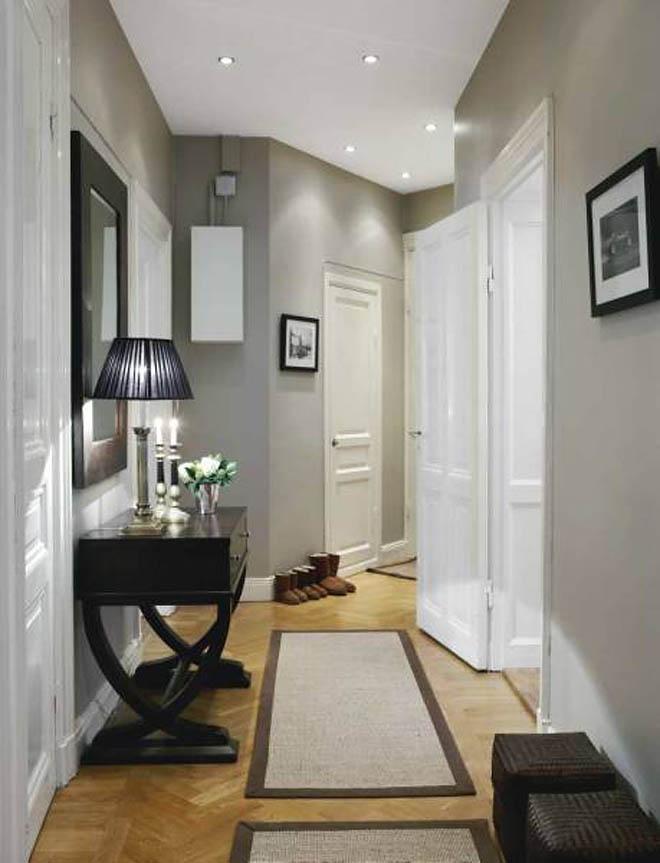 Plain wall colors are suitable for a narrow hallway
Plain wall colors are suitable for a narrow hallway  Vertical stripes on the walls visually increase the height of the ceiling
Vertical stripes on the walls visually increase the height of the ceiling 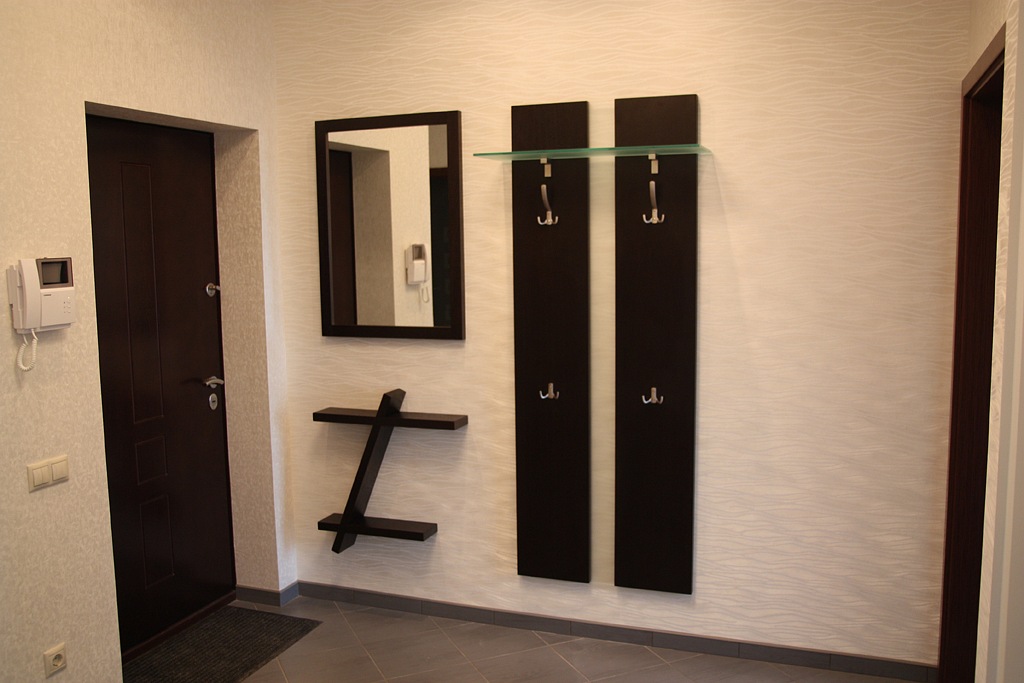 Compact furniture in minimal quantities is comfortable and practical
Compact furniture in minimal quantities is comfortable and practical  Illumination around the perimeter of the mirror provides comfort
Illumination around the perimeter of the mirror provides comfort  Corner shelves allow you to store small items
Corner shelves allow you to store small items 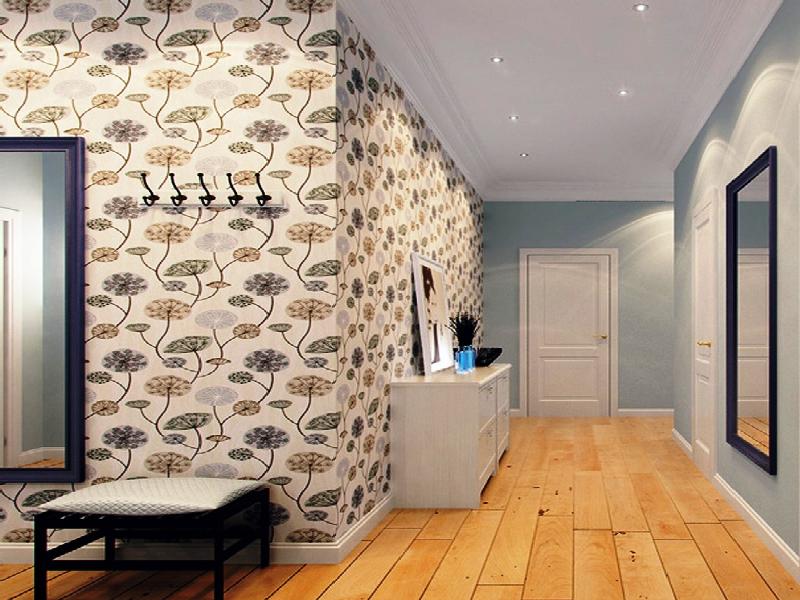 The pattern on the wallpaper can be medium or large in size
The pattern on the wallpaper can be medium or large in size  Contrasting patterned wallpapers go well with glossy surfaces
Contrasting patterned wallpapers go well with glossy surfaces  Illuminated paintings are suitable for a narrow hallway
Illuminated paintings are suitable for a narrow hallway  Extensive patterns on the wallpaper create stylish interior
Extensive patterns on the wallpaper create stylish interior
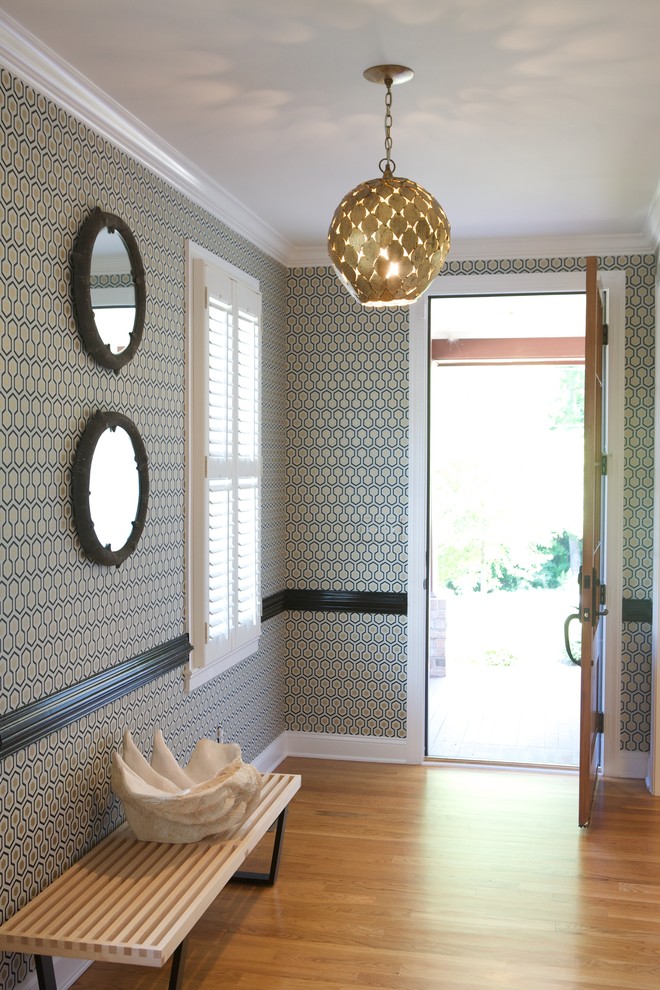 Any print on the wallpaper attracts attention
Any print on the wallpaper attracts attention
A long room of small width always requires careful arrangement and planning. This is how you can create a functional, comfortable space. Therefore, when designing a long corridor or narrow hallway, it is important to take into account all the key points and use design solutions.
When arranging their homes, many leave the design of the hallway for last. Nevertheless, this room can be called a kind of calling card of any home, since people view the corridor when entering the apartment. In many old houses you can see small hallways, as well as narrow and long corridors with dark walls and lack of lighting. This layout optically conceals the space. It’s easy to visually expand it by applying the techniques described in this article.
Traditionally, a narrow and long passage between rooms for different purposes is called a corridor. In different eras its layout changed according to development architectural styles. Related concepts, such as hall and vestibule, carry a slightly different meaning - this is the name for larger rooms, which may have other shapes (including round, polygonal). In addition, the corridor usually goes deep into the home, connecting various rooms, and can be a continuation of the hallway or hall. An elongated, dimly lit corridor carries a functional load, but does not make the interior cozy enough. Quite often you can observe the layout of an apartment, when corridors branch off from a small square or rectangular hallway towards the kitchen, as well as to the living quarters. The main task of designing a narrow corridor in an apartment is to give it optically greater width and spaciousness, as well as improve the degree of illumination.
If you are interested in how to design a narrow corridor, you should pay attention to the following information. It is known that in any elongated room of small width one can observe the so-called tunnel effect, in which it seems that the free space at the top is narrower than under the feet. Due to improper design of a narrow, elongated corridor in a closed and darkened space, a depressing impression of a cramped box may arise. You can visually “pull apart” the walls with the help of a thoughtful design of a narrow corridor. Sometimes this room is attached to next room. It is worth noting that such redevelopment requires approval, and moreover, it is not always possible - often the wall separating the corridor and the adjacent room is load-bearing, in which case it cannot be removed. In addition, combining the passage area with the living area will entail certain inconveniences; it is more expedient and hygienic to leave the layout in its original form. Sometimes one of the adjacent walls (not load-bearing) is replaced with a glass partition to let more light into the corridor.
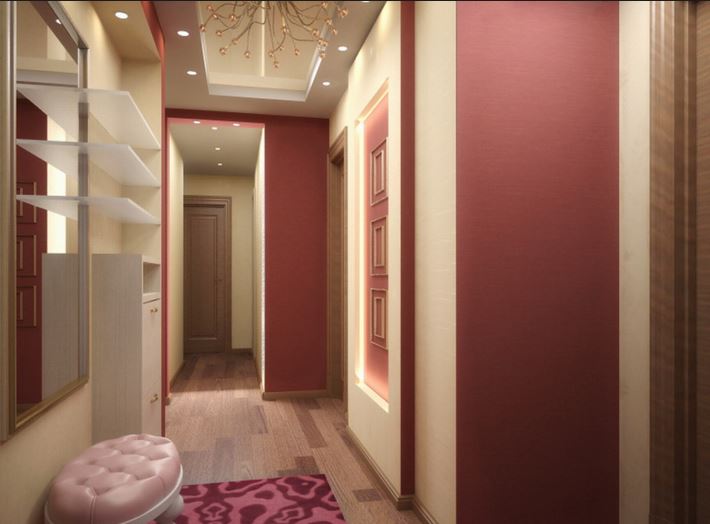
Basic techniques for designing a narrow corridor
When updating the interior of a narrow corridor, you will need to carefully consider its design. It is not difficult to arrange the space of a given room in an optimal way - to do this you will need to arm yourself with the following fairly common and proven techniques.
Wall decoration
Visually adjust the space of a narrow corridor in a Khrushchev building, as well as other rooms small size, it is possible with the help of competent color selection. First of all, you should pay attention to light shades. White expands the space and creates the impression of rooms filled with light - however, the corridor is a passage room in which the white walls will quickly get dirty. Thus, when selecting color scheme When finishing this room, it is recommended to opt for not too saturated, neutral light colors(these include cream, sand, light gray, vanilla), as well as in cold light shades of blue, mint, turquoise. It is not recommended to use light shades of blue and lilac, since these tones do not have the ability to optically expand the space, and also largely depend on the lighting. Glossy wall surfaces will be reflected opposite each other and will give the interior of a narrow long corridor an impressiveness and a feeling of spaciousness.

You should be especially careful when using bright contrasts in decoration, as they visually fragment an already small room and conceal its volume. Some designers recommend using a combination of two similar tones when decorating walls - in such cases, select light color, for the bottom - a darker shade. The color border, which runs horizontally along the walls, is created using moldings matched to match the trim on the door. This finishing method will help get rid of the notorious tunnel effect in a narrow (but not too long) corridor. In this case, it is necessary to take into account that you should choose a non-contrast, fairly soft color combination(for example, milky and a hint of cocoa with milk).
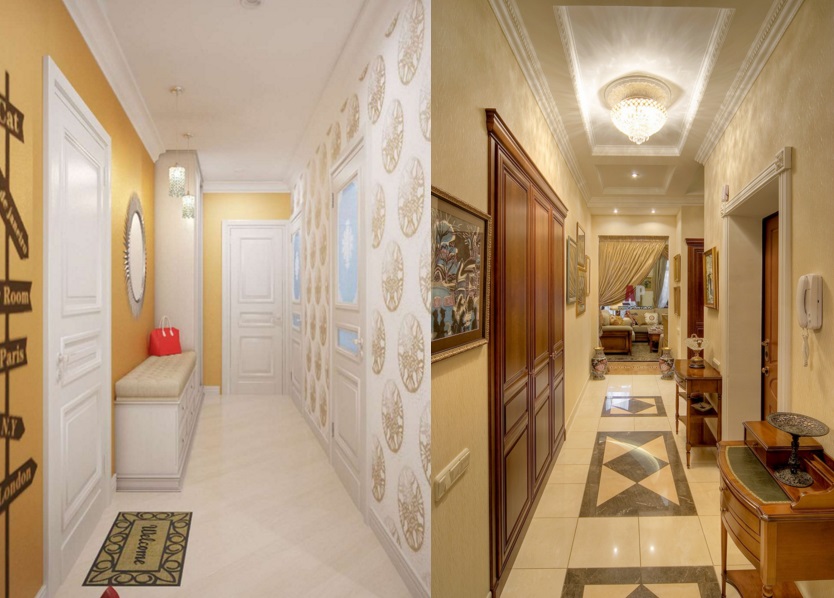
When choosing a suitable finish for walls, you should give preference to smooth textures, because corrugated materials in a narrow corridor can quickly lose their spectacular appearance. When finishing a narrow corridor it is not recommended to use wall panels(plastic or PVC), since this finish resembles an office atmosphere and can look cheap. In addition, you should not tile the walls below.
As an alternative to painting the walls and wallpapering, you can use the following ideas for decorating a narrow corridor:
- apply Venetian plaster with a smooth texture or liquid wallpaper - data finishing materials They are durable and easy to clean. It is also convenient to care for vinyl and cork wallpaper;
- line the walls from below with clapboard or laminate, and then paint them suitable color. The upper part of the walls can also be covered with paintable wallpaper;
- combine the finishing of individual elements of the room decorative stone or with plaster and wallpaper.
Floor decoration
When decorating the floor of a long and narrow corridor in an apartment, it is necessary to take into account the following - it is necessary to avoid longitudinal stripes in the decoration, which visually “stretch” the room and make it even narrower. A light or glossy floor will visually expand the space and give the room the missing volume. However, a smooth floor slips, so it is recommended to give preference to at least slightly corrugated surfaces. You should not use very dark colors for the floor - the slightest specks of dust are clearly visible on them, the appearance of which in such a passage place simply cannot be avoided. Light tones of wood, as well as soft or medium-colored tile tones, look great on the floor in a narrow corridor. A light floor is suitable, including if the wall decoration is combined in two tones, and bottom part They are decorated in fairly rich shades.

In the corridor leading from the hallway to the rooms, it is recommended to place the same carpet on the floor as in the living areas. You can tile only the floor in the hallway, or there and in the corridor leading to the kitchen (it is most advisable to use the same tile covering on the floor - or a different one, if the design of the kitchen space requires it). As for the paths, rugs with wide transverse stripes or graphic patterns fit well into the design of a narrow corridor in Khrushchev.

Furniture and doors, mirrors
If you have a narrow corridor starting from the hallway, you should make sure that the doors within sight (and the entrance door too) are the same color. In addition, it will be necessary to standardize the baseboards in a similar way. Ideal when a narrow corridor does not end with a door. Existing doors can be designed in the form of arches, or blind structures can be replaced light door frames with glass or mirrors, as well as curtains or interior curtains light curtains from threads, beads, bamboo. If you increase the height of the existing doorways, the interior of a narrow corridor will look more solemn and stylish. In addition, you can raise the doorways upward, and leave the doors of normal dimensions.

It is desirable that the furniture in the hallway matches the color of the door. In a similar way, you can ensure that the space is decorated in a single style and, due to this, visually acquires greater volume. If the area allows, you can place it in the corridor convenient wardrobe, including a mirrored door - you can place everything you want to keep at hand and out of sight. Such furniture can be made to order according to the dimensions of the room. If free space There is practically no room for placing furniture; you can attach small hooks and hangers to the walls to place outerwear after coming from the street. The narrow corridor should not be cluttered.

If you enter this room sunlight it makes sense to hang a mirror on the illuminated wall so that it reflects it - usually such a place is at the beginning or end of the corridor. If you place two mirrors on one wall, the corridor will optically expand. By placing a picture opposite them, either artistic modeling, you can get rid of the effect of empty space.
It will also benefit from transforming a narrow corridor:
- false window with a mirror in a blind wall - this detail is functional and looks aesthetically pleasing;
- wardrobe with mirrored doors;
- a mirror wall that optically doubles the space of the corridor and creates the illusion of additional free space. This design of the end wall looks especially good, and you will need to take care to mark the mirror, for example, with an ornament so that guests do not “enter” it;
- a traditional framed mirror or a classic dressing table;
- a mirror placed in a niche between the cabinets;
- large full-length mirror mounted on the floor. It is not recommended to install it at the end of a long corridor, so as not to get the reflection of an “endless tunnel”.
Ceiling decoration, lighting and wall decor
The design of the wall and ceiling surfaces in light colors - you need to try to achieve the effect of a single space, when the transitions between them are smoothed out as much as possible. If there are glossy surfaces, glare of light will be reflected in them advantageously, and the ceiling will appear higher and the corridor more spacious. In addition, you can successfully play on the contrast of a light glossy ceiling and a matte floor covering of a rich color.
First of all, you should remember that for such a room you should organize high-quality lighting. If you have a short corridor (less than three meters in length), you can install one ceiling lamp, placing it in the central part of the ceiling. For a longer corridor it is preferable to use several ceiling lamps(chandeliers, lamps or spots) placed at an equal distance from each other, so that the rays of light spread evenly.

To achieve the desired degree of illumination, you will need to use sufficiently powerful lamps. To illuminate a narrow corridor, you should not use fluorescent lamps, as they distort color rendition. In order to obtain light that is closest in spectrum to natural light, it is recommended to use halogen lamps or ordinary incandescent light bulbs. To illuminate shelves and mirrors, you can use spotlights.
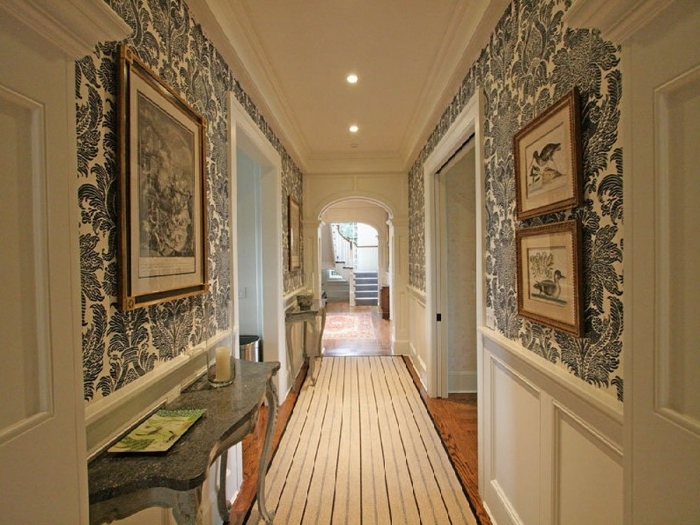
Considering the small distance between the walls, it is not recommended to place lamps on them, even very nice ones, since they take up such scarce space, distract attention to themselves, visually narrowing the already narrow corridor. The same can be said about various wall decor in the form of paintings, engravings or photos - you should consider how appropriate it is to place them on the walls of a given room, so as not to create unnecessary cluttering of the space. Most likely, it makes sense to place several decorative items on the walls in the form of small individual accents.
Narrow corridors - photo


